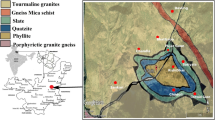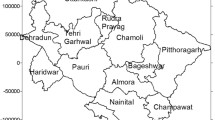Abstract
The present work deals with the assessment of annual inhalation dose due to exposure of indoor radon, thoron and their progeny concentrations in the villages situated in sub-mountainous region of Jammu & Kashmir, India. The distribution of the data and the homogeneity of medians among different seasons and dwellings were assessed with the Shapiro–Wilk test and the Mann–Whitney test. The estimated total annual inhalation dose in these villages varied from 0.5 to 1.9 mSv year−1 which is less than the prescribed limit by ICRP (2008). Thus, the investigated area is safe from irradiation of radon, thoron and their progeny.











Similar content being viewed by others
References
UNSCEAR (2000) Sources and effects of ionizing radiation. UNSCEAR 2000 report to the general assembly, with scientific annexes, vol I. United Nations, New York
Kudo H, Tokonami S, Omori Y, Ishikawa T, Iwaoka K, Sahoo SK, Akata N, Hosoda M, Wanabongse P, Pornnumpa C, Sun Q, Li X, Akiba S (2015) Comparative dosimetry for radon and thoron in high background radiation areas in China. Radiat Prot Dosim. https://doi.org/10.1093/rpd/ncv235
Ramola RC, Negi MS, Choubey VM (2005) Radon and thoron monitoring in the environment of Kumaun Himalayas: survey and outcomes. J Environ Radioact 79:85–92. https://doi.org/10.1016/j.jenvrad.2004.05.012
Lubin JH, Boice JD (1997) Lung cancer risk from residential radon meta-analysis of eight epidemiology studies. J Natl Cancer Inst 89(1):49–57. https://doi.org/10.1093/jnci/89.1.49
Pershagen G, Akerblom G, Axelson O, Clavensjo B, Damber L, Desai G, Enflo A, Lagarde F, Mellander H, Svartengren M, Swedjemark GA (1994) Residential radon exposure and lung cancer in Sweden. N Engl J Med 330:159–164. https://doi.org/10.1056/NEJM199401203300302
UNSCEAR (2006) Sources and effects of ionizing radiation (report to general assembly with scientific annexes. United Nations, New York
UNSCEAR (1993) Sources and effects of ionizing radiation. UNSCEAR 1993 report to the general assembly, with annexes. United Nations, New York, pp 73–98
Porstendorfer J (1994) Properties and behaviour of radon and thoron and their decay products in the air. J Aerosol Sci 25:219–263. https://doi.org/10.1016/0021-8502(94)90077-9
Yu KN, Cheung T, Guan ZJ, Young ECM, Mui BWN, Wong YY (1999) Concentrations of 222Rn, 220Rn and their progeny in residences in Hong Kong. J Environ Radioact 45:291–308. https://doi.org/10.1016/S0265-931X(98)00114-3
Singh S, Kumar A, Singh B (2002) Radon level in dwellings and its correlation with uranium and radium content in some areas of Himachal Pradesh, India. J Environ Int 28(1–2):97–101. https://doi.org/10.1016/S0160-4120(02)00012-0
Stojanovska Z, Januseski J, Bossew P, Zunic ZS, Tollefsen T, Ristova M (2011) Seasonal indoor radon concentration in FYR of Macedonia. Radiat Meas 46:602–610. https://doi.org/10.1016/j.radmeas.2011.04.022
Szabo Z, Jordan G, Szabo C, Horvath A, Holm O, Kocsy G, Csige I, Szabo P, Homoki Z (2014) Radon and thoron levels, their spatial and seasonal variations in adobe dwellings—a case study at the Great Hungarian Plain. Isot Environ Health Stud 50(2):211–225. https://doi.org/10.1080/10256016.2014.862533
Bangotra P, Mehra R, Kaur K, Kanse S, Mishra R, Sahoo BK (2015) Estimation of EEC, unattached fraction and equilibrium factor for the assessment of radiological dose using pin-hole cup dosimeters and deposition based progeny sensors. J Environ Radioact 148:67–73. https://doi.org/10.1016/j.jenvrad.2015.06.010
Prasad M, Rawat M, Dangwal A, Kandari T, Gusian GS, Mishra R, Ramola RC (2016) Variability of radon and thoron equilibrium factors in indoor environment of Garhwal Himalaya. J Environ Radioact 151:238–243. https://doi.org/10.1016/j.jenvrad.2015.10.017
Ramola RC, Prasad M, Kandari T, Pant P, Bossew P, Mishra R, Tokonami S (2016) Dose estimation derived from the exposure to radon, thoron and their progeny in the indoor environment. Sci Rep. https://doi.org/10.1038/srep31061
Singh P, Saini K, Mishra R, Sahoo BK, Bajwa BS (2016) Attached, unattached fraction of progeny concentrations and equilibrium factor for dose assessments from 222Rn and 220Rn. Radiat Environ Biophys. https://doi.org/10.1007/s00411-016-0656-3
Shapiro SS, Wilk MB (1965) An analysis of variance test for normality (complete samples). Biometrika 52(3/4):591–611. http://www.jstor.org/stable/2333709
Mann HB, Whitney DR (1947) On a test of whether one of two random variable is stochastically larger than the other. Ann Math Stat 18:50–60. https://doi.org/10.1214/aoms/1177730491
Tukey JW (1977) Exploratory data analysis. Addison-Wesley, Boston, pp 530–537
Sahoo BK, Sapra BK, Kanse SD, Gaware JJ, Mayya YS (2013) A new pin-hole discriminated 222Rn/220Rn passive measurement device with single entry face. Radiat Meas 58:52–60. https://doi.org/10.1016/j.radmeas.2013.08.003
Mishra R, Mayya YS, Khushwaha HS (2009) Measurement of 220Rn/222Rn progeny deposition velocities on surfaces and their comparison with theoretical models. J Aerosol Sci 40:1–15. https://doi.org/10.1016/j.jaerosci.2008.08.001
Mishra R, Mayya YS (2008) Study of a deposition-based direct thoron progeny sensor (DTPS) technique for estimating equilibrium equivalent thoron concentration (EETC) in indoor environment. Radiat Meas 43:1408–1416. https://doi.org/10.1016/j.radmeas.2008.03.002
Kaur M, Kumar A, Mehra R, Mishra R (2017) Assessment of attached, un-attached progeny concentrations of 222Rn/220Rn and their contribution to dose using deposition based progeny sensors. Earth Environ Sci. https://doi.org/10.1007/s12665-017-6874-4
Kaur M, Kumar A, Mehra R, Mishra R (2017) Comparative study of 222Rn/220Rn Progeny concentration and estimation of age-dependent dose due to inhalation of radon progeny for different body organs. Human Eco Risk Assess. https://doi.org/10.1080/10807039.2017.1392234
Mishra R, Sapra BK, Mayya YS (2014) Multi-parametric approach towards the assessment of radon and thoron progeny exposures. Rev Sci Inst 85(1–8):022105. https://doi.org/10.1063/1.4865165
Ramola RC, Negi MS, Choubey VM (2003) Measurements of equilibrium factor “F” between radon and its progeny and thoron and its progeny in the indoor atmosphere using nuclear track detectors. Indoor Built Environ 12:351–355. https://doi.org/10.1177/142032603035368
ICRP (2011) Lung cancer risk from radon and progeny. ICRP Publication-115. International Commission on Radiological Protection
WHO (2009) WHO handbook on indoor radon: a public health perspective. World Health Organization
USEPA (1991) National primary drinking water regulations; radio nuclides; proposed rules. Federal register, vol 56. U.S. Environmental Protection Agency, p 33050
ICRP (2010) Lung Cancer risk from radon and progeny and statement on radon. ICRP publication 115. Annals of the ICRP, vol 40(1). International Commission on Radiological Protection
ICRP (1993) Protection against radon-222 at home and at work. ICRP Publication 65. Annals of the ICRP, vol 23(2)
ICRP (2008) International commission on radiological protection. Radiation dose to patients from radiopharmaceuticals. ICRP International Commission on Radiological Protection, vol 38, n. 1–2. Pergamon Press, Oxford
Ramola RC, Kandari MS, Rawat RSS, Ramachandran TV, Choubey VM (1988) A study of seasonal variations of radon levels in different type of houses. J Environ Radioact 39:1–7. https://doi.org/10.1016/j.jrras.2014.02.007
Sesana L, Caprioli E, Marcazzan GM (2003) Long period study of outdoor radon concentration in Milan and correlation between its temporal variations and dispersion properties of atmosphere. J Environ Radioact 65:147–160. https://doi.org/10.1016/S0265-931X(02)00093-0
Ramachandran TV, Muraleedharan TS, Shaikh AN, Subha Ramu MC (1989) Seasonal variation of indoor radon and its progeny concentration in dwellings. Atmos Environ 24(3):639–643. https://doi.org/10.1016/0960-1686(90)90019-J
Kumar A, Chauhan RP, Joshi M, Aggarwal P (2015) Implications of variability in indoor radon/thoron levels: a study of dwellings in Haryana, India. Environ Earth Sci 73:4033–4042. https://doi.org/10.1007/s12665-014-3688-5
Acknowledgements
The authors are profoundly grateful to the residents of Jammu district, Jammu & Kashmir India, for their cooperation and help for placing dosimeters and DRPS/DTPS in their respective dwellings. Our special thanks to D.A.V. College, Amritsar and National Institute of Technology, Jalandhar for their support in carrying out the experimental work.
Funding
The authors are thankful to the Board of Research in Nuclear Sciences (BRNS), Department of Atomic Energy (DAE), Government of India, for providing financial assistance under a major research project (Project No. 2013/36/60-BRNS) for this study.
Author information
Authors and Affiliations
Corresponding author
Rights and permissions
About this article
Cite this article
Kaur, M., Kumar, A., Mehra, R. et al. Dose assessment from exposure to radon, thoron and their progeny concentrations in the dwellings of sub-mountainous region of Jammu & Kashmir, India. J Radioanal Nucl Chem 315, 75–88 (2018). https://doi.org/10.1007/s10967-017-5632-0
Received:
Published:
Issue Date:
DOI: https://doi.org/10.1007/s10967-017-5632-0




